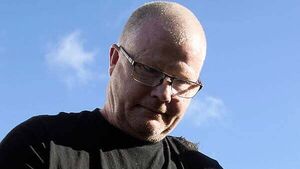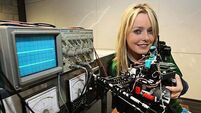Tina Satchwell's cause of death unclear due to skeletal nature of remains, court hears

Alison O'Riordan
Tina Satchwell's cause of death could not be determined due to the skeletal nature of her remains after they were found buried beneath her Cork home, the Assistant State Pathologist has told the Richard Satchwell murder trial.
The Central Criminal Court also heard today that a dressing gown belt had been knotted to the front of Tina's chest in a "very unusual position", which expert witness Dr Margaret Bolster said is very often used for carrying a body.
The trial has heard that on March 24th, 2017, Mr Satchwell told gardaí that his wife Tina had left their home four days earlier but that he had no concerns over her welfare, feeling she had left due to a deterioration in their relationship.
The accused formally reported Ms Satchwell missing the following May, but her body was not discovered for over six years, when gardaí in October 2023, conducting "an invasive search" of the Satchwell home, found her decomposed remains in a grave that had been dug underneath the stairs.
When re-arrested on suspicion of Tina's murder after her body was removed from their Cork home, Mr Satchwell told gardaí that his wife "flew" at him with a chisel, that he fell backwards against the floor and described her death after he said he held her off by the belt of her bathrobe at her neck.
Postmortem
Giving evidence today, Dr Bolster told Gerardine Small SC, prosecuting, that she went to Grattan Street in Youghal on October 12th, 2023, where the deceased's skeletal remains were uncovered from a hole under the stairs with a depth of approximately 62cms.
The witness said she conducted a postmortem on Ms Satchwell's remains on the evening of October 12th, which continued into the morning of October 13th in Cork city mortuary.
Dr Bolster said the body was recovered in a St Bernard dressing gown in a size 14-16, and it had been wrapped in a soiled sheet and black plastic. She said a gold coloured purse labelled 'Playboy' had been removed from the left pocket of the dressing gown with cards in the name of Tina Satchwell inside.
She said she had cut the belt of the dressing gown to remove it and it hadn't been previously cut.
The belt extended over the left side of the neck, under the right shoulder and right arm, under the body and was then knotted on the front of the chest.
The witness said the dressing gown top had disintegrated, and multiple ribs and vertebrae had come apart through decomposition. The next layer of clothing underneath were pyjamas.
She said the belt had not been threaded through the loops of the dressing gown and that the left-hand side of the belt was across the front of the thorax.
Expert witness
The expert witness testified that four pieces of glass were taken from the scalp and five from the rest of the body.
There was also evidence that the head had been separated from the body through decomposition.
The witness pointed out that part of the body had been skeletonised, and she could not identify external marks and injuries due to this.
She said an internal examination was not applicable as there were no remaining organs.
Furthermore, the witness testified that there was no evidence of any fractures of the bones, including the hyoid bone in the neck. An X-ray of the hands was carried out and it showed no evidence of fractures.
The witness said that, due to a very long postmortem interval, Ms Satchwell's cause of death could not be determined. "It could not be determined due to the skeletal nature of the remains," she concluded.
Dr Bolster said the significance of a dressing gown belt over the front of the neck was unclear. "It was in a very unusual position as there had been significant moving and wrapping of the body after death," she said.
In cross-examination, Dr Bolster told Brendan Grehan SC, defending, that the body was found lying face down and had been wrapped in a soiled sheet like a bedsheet.
The witness agreed with the defence counsel that underneath the sheet, the body was wearing a dressing gown with the belt knotted to the front of the chest, which seemed "quite tight or taught" around the torso.
Reconstruction video
A reconstruction video was shown to the jury as to how Dr Bolster recalled the belt around the remains of Ms Satchwell.
Asked whether the belt appeared to be like "something used to carry the body", Dr Bolster said these were exactly her thoughts. "It's very difficult to move a deceased's body around, and very often I find ligatures are used to move a body from an area," she said.
Mr Grehan put it to the witness that "someone would have put it on to assist in the leverage of a body. "Yes, to move it around," she replied.
She couldn't say where the glass found on the body had come from.
The witness told Mr Grehan that in manual strangulation or throttling cases, it is much more common to find fractures in the hyoid bones. She confirmed there was no evidence of trauma to any bones and no evidence of bruising insofar as she could examine what was left of the muscle.
She agreed that one of the arms was folded up against the chest area as it lay, and that the other arm also flexed.
In conclusion, Dr Bolster said she could "very clearly" see the belt had been knotted "at the front" of the body in a "very unusual position", which is "very often used for leverage of the deceased".





